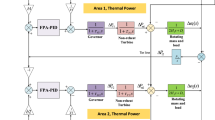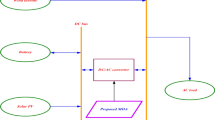Abstract
A multi-objective optimal power flow (OPF) solution using an enhanced NSPSO, incorporating chaotic mutation and stochastic weight trade-off features, is proposed here. The objective functions considered embody the different aspects of the power system, viz. financial, reliability and operational efficiency. The proposed OPF algorithm balances the exploration of global and the utilization of local bests with the stochastic weight and dynamic coefficient trade-off techniques, thus enhancing the searching capability. Also, for countering the premature convergence issue and to improve diversity, the feature of chaotic mutation is incorporated. The pareto-optimal front is provided by the combination of crowding distance approach and non-dominated sorting principle. The best solution can be obtained from a dual-stage process, by selecting from the collective of local best compromises using a fuzzy function. To assess the performance, the proposed method is tested on a standard IEEE 30-bus test system and is compared with popular multi-objective algorithms. IEEE 118-bus system is also used for testing applicability to large systems. Based on the obtained results, the proposed method gives a more reliable operating solutions, better optimal front and hence an improved solution providing a better trade-off.

















Similar content being viewed by others
Abbreviations
- \(C_F\) :
-
Total generator fuel cost ($/h)
- \(N_\mathrm{GEN}\) :
-
Number of conventional generators
- \(a_i\), \(b_i\), \(c_i\) :
-
Cost efficiency of conventional generator i
- \(P_{Gi}\) :
-
Active power output of conventional generator i (MW)
- \(W_{si}\), \(W_{ri}\), \(W_{ai}\) :
-
Scheduled, rated and actual wind powers
- \(v_i\) :
-
Wind speed
- \(v_{\mathrm{in},i}\), \(v_{ri}\), \(v_{\mathrm{out},i}\) :
-
The cut-in, rated and cut-out wind speeds
- \(C_i\) , \(K_i\) :
-
Scale and shape factors of Weibull PDF
- \(N_W\) :
-
Number of wind farms
- \(d_i\),\(d_{Pwi}\), \(d_{Rwi}\) :
-
Direct, penalty and reserve cost coefficients
- \(V_{Gi}\) :
-
Voltage magnitude of generator bus i (p.u.)
- \(V_{Li}\) :
-
Voltage magnitude of load busi (p.u.)
- \(N_L\) :
-
Number of load buses
- \(P_\mathrm{loss}\) :
-
Transmission system loss (MW)
- \(g_l\) :
-
Conductance of transmission line l
- \(V_{i}\), \(V_{j}\), \(\delta _{i}\), \(\delta _j\) :
-
Voltage magnitudes and angles for buses i and j (p.u.)
- s, u :
-
Vector of dependent and control variables
- \(f_\mathrm{obj}\) :
-
Objective function
- g(s, u):
-
Equality constraints of vector s and u
- h(s, u):
-
Inequality constraint of vector s and u
- \(P_i\), \(Q_i\) :
-
Active and reactive power injection of bus i (MW)
- \(P_{Di}\), \(Q_{Di}\) :
-
Active and reactive power load demand of bus i (MW)
- \(G_{ij}\), \(B_{ij}\) :
-
Conductance and susceptance between bus i and j
- \(P_{Gi}\), \(Q_{Gi}\), \(V_{Gi}\) :
-
Active power, reactive power and voltage magnitude of generator bus i
- \(T_i\) :
-
Tap setting of transformer i
- \(Q_{Ci}\) :
-
Shunt VAR compensation of compensator i
- \(S_{Li}\) :
-
Line flow of transmission line i
- \(P_{Gi}^{\min }\), \(P_{Gi}^{\max }\) :
-
Minimum and maximum active power output of conventional generator i (MW)
- \(Q_{Gi}^{\min }\), \(Q_{Gi}^{\max }\) :
-
Minimum and maximum reactive power output of conventional generator i (MW)
- \(T_i^{\min }\), \(T_i^{\max }\) :
-
Minimum and maximum tap setting of transformer i
- \(Q_{Ci}^{\min }\), \(Q_{Ci}^{\max }\) :
-
Minimum and maximum shunt VAR compensation by compensator i
- \(V_{Li}^{\min }\), \(V_{Li}^{\max }\) :
-
Minimum and maximum voltage magnitude of load bus i
- \(S_{Li}^{\min }\), \(S_{Li}^{\max }\) :
-
Minimum and maximum line flow of transmission line i
- \(N_\mathrm{line}\) :
-
Total number of transmission lines
- \(N_{Tr}\) :
-
Number of transformers
- \(N_C\) :
-
Number of shunt VAR compensators
- \(N_\mathrm{obj}\) :
-
Number of objective functions
- \(\lambda \)P, \(\lambda \)V, \(\lambda \)Q, \(\lambda \)S:
-
Penalty coefficients
- k, \(k_{\max }\) :
-
Current and maximum number of iterations
- n :
-
Number of particles
- D:
-
Number of optimized variables
- \(v_{id}^k\), \(x_{id}^k\) :
-
Velocity and position of particle i in dimension d of k iteration
- \(v_{id,\min }\), \(v_{id,\max }\) :
-
Minimum and maximum values of particle velocity
- \(x_{id,\min }\), \(x_{id,\max }\) :
-
Minimum and maximum values of position
- \(\omega (k)\) :
-
Inertia weight of iteration k
- \(\omega _{\max }\), \(\omega _{\min }\) :
-
Maximum and minimum value of inertia weight
- \(C_1(k)\), \(C_s(k)\) :
-
Cognitive and social acceleration coefficients of iteration k
- \(C_{1,\min }\), \(C_{1,\max }\) :
-
Minimum and maximum cognitive acceleration coefficients
- \(C_{2,\min }\), \(C_{2,\max }\) :
-
Minimum and maximum social acceleration coefficients
- \(pbest_{id}^k\) :
-
Local best particle i in dimension d of iteration k
- \(pbest_{id}^k\) :
-
Global best particle
- \(r_1\),\(r_2\), \(r_3\), \(r_4\) :
-
Random numbers between 0 to 1 with uniform distribution
- \(P_{ltg}\), \(P_{fr}\) :
-
Lethargy and freak factors
- \(v_{id}^{frk}\) :
-
Normal random velocity of the interval [\(v_{id, \min }\), \(v_{id,\max }\)]
- \(f_{\mathrm{obj},i}^{\min }\), \(f_{\mathrm{obj},i}^{\max }\) :
-
Minimum and maximum values of the objective function i
- \(f_i\) :
-
Membership function of the objective function i
- \(f^{j}\) :
-
Selecting function of non-dominated solution j
- m :
-
Number of non-dominated solutions
References
Abou El Ela AA, Abido MA, Spea SR (2010) Optimal power flow using differential evolution algorithm. Electr Power Syst Res 80(7):878–885. https://doi.org/10.1016/J.EPSR.2009.12.018
Niknam T, rasoul Narimani M, Jabbari M, Malekpour AR (2011) A modified shuffle frog leaping algorithm for multi-objective optimal power flow. Energy 36(11):6420–6432. https://doi.org/10.1016/j.energy.2011.09.027
Wood AJ, Wollenberg BF (1996) Power generation, operation, and control, vol 37. https://doi.org/10.1016/0140-6701(96)88714-5
Kumari MS, Maheswarapu S (2010) Enhanced genetic algorithm based computation technique for multi-objective optimal power flow solution. Int J Electr Power Energy Syst 32(6):736–742. https://doi.org/10.1016/j.ijepes.2010.01.010
Sivasubramani S, Swarup KS (2011) Multi-objective harmony search algorithm for optimal power flow problem. Int J Electr Power Energy Syst 33(3):745–752. https://doi.org/10.1016/j.ijepes.2010.12.031
Davoodi Elnaz, Babaei Ebrahim, Mohammadi-ivatloo Behnam (2018) An efficient covexified SDP model for multi-objective optimal power flow. Int J Electr Power Energy Syst 102:254–64. https://doi.org/10.1016/j.ijepes.2018.04.034
Abaci Kadir, Yamacli Volkan (2016) Differential search algorithm for solving multi-objective optimal power flow problem. Int J Electr Power Energy Syst 79:1–10. https://doi.org/10.1016/j.ijepes.2015.12.021
Mandal B, Roy PK (2014) Multi-objective optimal power flow using quasi-oppositional teaching learning based optimization. Appl Soft Comput 21:590–606. https://doi.org/10.1016/j.asoc.2014.04.010
Medina MA, Das S, Coello CAC, Ramírez JM (2014) Decomposition-based modern metaheuristic algorithms for multi-objective optimal power flow—A comparative study. Eng Appl Artif Intell 32:10–20. https://doi.org/10.1016/j.engappai.2014.01.016
Bhowmik AR, Chakraborty AK (2014) Solution of optimal power flow using nondominated sorting multi objective gravitational search algorithm. Int J Electr Power Energy Syst 62:323–334. https://doi.org/10.1016/j.ijepes.2014.04.053
Radosavljević Jordan, Jevtić Miroljub, Arsić Nebojša, Klimenta Dardan (2014) Optimal power flow for distribution networks using gravitational search algorithm. Electr Eng 96(4):335–45. https://doi.org/10.1007/s00202-014-0302-5
Ghasemi M, Ghavidel S, Rahmani S, Roosta A, Falah H (2014) A novel hybrid algorithm of imperialist competitive algorithm and teaching learning algorithm for optimal power flow problem with non-smooth cost functions. Eng Appl Artif Intell 29:54–69. https://doi.org/10.1016/j.engappai.2013.11.003
Narimani MR, Azizipanah-Abarghooee R, Zoghdar-Moghadam-Shahrekohne B, Gholami K (2013) A novel approach to multi-objective optimal power flow by a new hybrid optimization algorithm considering generator constraints and multi-fuel type. Energy 49:119–136. https://doi.org/10.1016/j.energy.2012.09.031
Ghasemi M, Ghavidel S, Ghanbarian MM, Gharibzadeh M, Vahed AA (2014) Multi-objective optimal power flow considering the cost, emission, voltage deviation and power losses using multi-objective modified imperialist competitive algorithm. Energy 78:276–289. https://doi.org/10.1016/j.energy.2014.10.007
Devaraj D (2007) Improved genetic algorithm for multi-objective reactive power dispatch problem. Eur Trans Electr Power 17(6):569–581. https://doi.org/10.1002/etep.146
Panda A, Tripathy M (2016) Solution of wind integrated thermal generation system for environmental optimal power flow using hybrid algorithm. Int J Electr Power Energy Syst 3(2):151–160. https://doi.org/10.1016/j.jesit.2016.01.004
Galvani Sadjad, Marjani Saeed Rezaeian (2019) Optimal power flow considering predictability of power systems. Electr Power Syst Res 171:66–73. https://doi.org/10.1016/j.epsr.2019.02.011
Basu M (2016) Multi-objective optimal reactive power dispatch using multi-objective differential evolution. Int J Electr Power Energy Syst 82:213–24. https://doi.org/10.1016/j.ijepes.2016.03.024
Reddy S Surender (2018) Solution of multi-objective optimal power flow using efficient meta-Heuristic algorithm. Electr Eng 100(2):401–13. https://doi.org/10.1007/s00202-017-0518-2
Bai W, Lee D, Lee K (2016) Stochastic dynamic optimal power flow integrated with wind energy using generalized dynamic factor model. IFAC-PapersOnLine 49(27):129–134. https://doi.org/10.1016/j.ifacol.2016.10.731
Liang R-H, Wu C-Y, Chen Y-T, Tseng W-T (2015) Multi-objective dynamic optimal power flow using improved artificial bee colony algorithm based on Pareto optimization. Int Trans Electr Energy Syst 26(4):692–712. https://doi.org/10.1002/etep.2101
Roy R, Jadhav HT (2015) Optimal power flow solution of power system incorporating stochastic wind power using Gbest guided artificial bee colony algorithm. Int J Electr Power Energy Syst 64:562–578. https://doi.org/10.1016/j.ijepes.2014.07.010
Taher Mahrous A, Kamel Salah, Jurado Francisco, Ebeed Mohamed (2019) Modified grasshopper optimization framework for optimal power flow solution. Electr Eng 101(1):121–48. https://doi.org/10.1007/s00202-019-00762-4
Panda A, Tripathy M (2014) Optimal power flow solution of wind integrated power system using modified bacteria foraging algorithm. Int J Electr Power Energy Syst 54:306–314. https://doi.org/10.1016/j.ijepes.2013.07.018
Panda A, Tripathy M (2015) Security constrained optimal power flow solution of wind-thermal generation system using modified bacteria foraging algorithm. Energy 93:816–827. https://doi.org/10.1016/j.energy.2015.09.083
Roy PK, Paul C (2014) Optimal power flow using krill herd algorithm. Int Trans Electr Energy Syst 25(8):1397–1419. https://doi.org/10.1002/etep.1888
Jeddi B, Einaddin AH, Kazemzadeh R (2016) A novel multi-objective approach based on improved electromagnetism-like algorithm to solve optimal power flow problem considering the detailed model of thermal generators. Int Trans Electr Energy Syst 27(4):e2293. https://doi.org/10.1002/etep.2293
Shargh S, ghazani BK, Mohammadi-ivatloo B, Seyedi H, Abapour M (2016) Probabilistic multi-objective optimal power flow considering correlated wind power and load uncertainties. Renew Energy 94:10–21. https://doi.org/10.1016/j.renene.2016.02.064
Hazra J, Sinha AK (2010) A multi-objective optimal power flow using particle swarm optimization. Eur Trans Electr Power 21(1):1028–1045. https://doi.org/10.1002/etep.494
Chang YC, Lee TY, Chen CL, Jan RM (2014) Optimal power flow of a wind-thermal generation system. Electr Power Energy Syst 55:312–320
Jangir Pradeep, Parmar Siddharth A, Trivedi Indrajit N, Bhesdadiya RH (2017) Novel hybrid particle swarm optimizer with multi verse optimizer for global numerical optimization and optimal reactive power dispatch problem. Int J Eng Sci Technol 20(2):570–86. https://doi.org/10.1016/j.jestch.2016.10.007
Jiejin C, Xiaoqian M, Lixiang L, Haipeng P (2007) Chaotic particle swarm optimization for economic dispatch considering the generator constraints. Energy Convers Manag 48:645–653
Cai J, Ma X, Li Q, Li L, Peng H (2009) A multi-objective chaotic particle swarm optimization for environmental/economic dispatch. Energy Convers Manag 50:1318–1325
He D, Dong G, Wang F, Mao Z (2011) Optimization of dynamic economic dispatch with valve-point effect using chaotic sequence based differential evolution algorithms. Energy Convers Manag 52:1026–1032
Man-Im A, Ongsakul W, Singh JG, Boonchuay C (2015) Multi-objective optimal power flow using stochastic weight trade-off chaotic NSPSO. IEEE, Innovative Smart Grid Technologies, pp 1–8
Roy R, Jadhav HT (2015) Optimal power flow solution of power system incorporating stochastic wind power using gbest guided artificial bee colony algorithm. Int J Electr Power Energy Syst 64:562–578
Acknowledgements
The authors hereby acknowledge the partial financial support provided by the King HRD Scholarship, Energy Conservation and Promotion Fund, Ministry of Energy of Thailand.
Author information
Authors and Affiliations
Corresponding author
Additional information
Publisher's Note
Springer Nature remains neutral with regard to jurisdictional claims in published maps and institutional affiliations.
Appendix: The incomplete gamma function
Appendix: The incomplete gamma function
The function of overestimation cost:
where
where
where \(h_i =\left( {\frac{v_{ri} }{v_{in,i} }} \right) -1\)
With variable substitution, \(t=\left( {1+\frac{h_i W_{si} }{W_{ri} }} \right) vin,i.\)H\(_{31}\) is converted as follows.
With variable substitution, \(y=\left( {\frac{t_i }{C_i }} \right) ^{k},G_1 \) is converted as followed.
According to the definition of the incomplete gamma function (IGF).
Apply IGF into G\(_{1}\);
Therefore;
The function of underestimation cost:
where
The underestimation analysis is done in a similar method of overestimation cost.
Rights and permissions
About this article
Cite this article
Man-Im, A., Ongsakul, W., Singh, J.G. et al. Multi-objective optimal power flow considering wind power cost functions using enhanced PSO with chaotic mutation and stochastic weights. Electr Eng 101, 699–718 (2019). https://doi.org/10.1007/s00202-019-00815-8
Received:
Accepted:
Published:
Issue Date:
DOI: https://doi.org/10.1007/s00202-019-00815-8




